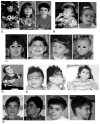Exclusion of linkage to the CDL1 gene region on chromosome 3q26.3 in some familial cases of Cornelia de Lange syndrome
- PMID: 11391654
- PMCID: PMC4896160
Exclusion of linkage to the CDL1 gene region on chromosome 3q26.3 in some familial cases of Cornelia de Lange syndrome
Abstract
Cornelia de Lange Syndrome (CdLS) is a complex developmental disorder consisting of characteristic facial features, limb abnormalities, hirsutism, ophthalmologic involvement, gastroesophageal dysfunction, hearing loss, as well as growth and neurodevelopmental retardation. Most cases of CdLS appear to be sporadic. Familial cases are rare and indicate autosomal dominant inheritance. Several individuals with CdLS have been reported with chromosomal abnormalities, suggesting candidate genomic regions within which the causative gene(s) may lie. A CdLS gene location (CDL1) has been assigned to 3q26.3 based on phenotypic overlap with the duplication 3q syndrome (critical region 3q26.2-q27) and the report of a CdLS individual with a balanced de novo t(3;17)(q26.3;q23.1). It has been postulated that a gene within the dup3q critical region results in the CdLS when deleted or mutated. We have performed a linkage analysis to the minimal critical region for the dup3q syndrome (that encompasses the translocation breakpoint) on chromosome 3q in 10 rare familial cases of CdLS. Nineteen markers spanning a region of approximately 40 Mb (37 cM) were used. Results of a multipoint linkage analysis demonstrated total lod-scores that were negative across the chromosome 3q26-q27 region. In 4/10 families, lod-scores were less than -2 in the 2 cM region encompassing the translocation, while in the remaining 6/10 families, lod-scores could not exclude linkage to this region. These studies indicate that in some multicase families, the disease gene does not map to the CDL1 region at 3q26.3.
Copyright 2001 Wiley-Liss, Inc.
Figures




References
-
- Annunen S, Korkko J, Czarny M, Warman ML, Brunner HG, Kaariainen H, Mulliken JB, Tranebjaerg L, Brooks DG, Cox GF, Cruysberg JR, Curtis MA, Davenport SLH, Friedrich CA, Kaitila I, Krawczynski MR, Latos-Bielenska A, Mukai S, Olsen BR, Shinno N, Somer M, Vikkula M, Zlotgora J, Prockop DJ, Ala-Kokko L. Splicing mutations of 54-bp exons in the COL11A1 gene cause Marshall syndrome, but other mutations cause overlapping Marshall/Stickler phenotypes. Am J Hum Genet. 1999;65:974–983. - PMC - PubMed
-
- Aqua MS, Rizzu P, Lindsay EA, Shaffer LG, Zackai EH, Overhauser J, Baldini A. Duplication 3q syndrome: molecular delineation of the critical region. Am J Med Genet. 1995;55:33–37. - PubMed
-
- Baldwin CT, Hoth CF, Amos JA, da-Silva EO, Milunsky A. An exonic mutation in the HuP2 paired domain gene causes Waardenburg’s syndrome. Nature. 1992;355:637–638. - PubMed
-
- Bankier A, Haan E, Birrell R. Letter to the editor: familial occurrence of Brachmann-de Lange syndrome. Am J Med Genet. 1986;25:163–165. - PubMed
Publication types
MeSH terms
Substances
Grants and funding
LinkOut - more resources
Full Text Sources
Other Literature Sources
Molecular Biology Databases
Research Materials
Miscellaneous
